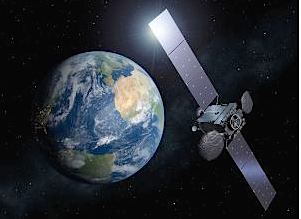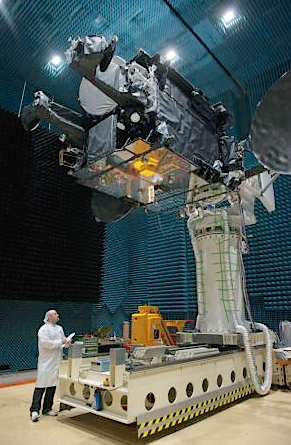
The testing of a satellite after the launch is not something that is done quickly. It takes time for the gamut of reviews by those at home base to determine if all is well. So it's good news all around when the H36W-1 telecommunications satellite supplied by OHB System AG, launched at the beginning of the year, has been handed over to Spanish satellite operator HispaSat following the completion of an In Orbit Test period of more than 80 days. This trial confirms the design and configuration of the new European SmallGEO satellite platform, simultaneously testifying to the fact that the German space industry has regained system capabilities for telecommunications satellites.

Artist’s impression of the SmallGEO-satellite H36W-1 in space © ESA

Marco Fuchs, the Chief Executive Officer of OHB System AG, at the hand-over of the satellite to HISPASAT said that with the successful hand-over of the SmallGEO satellite H36W-1, OHB has achieved an important strategic goal which is of crucial importance for the company’s future development. At the same time, part of the national space strategy is being implemented with the return to system capability. H36W-1 is the first satellite based on the SmallGEO platform developed by OHB. It was completed in the form of a private-public partnership comprising the European Space Agency (ESA), OHB and the HISPASAT. Fuchs continued that he wanted to thank the German Aerospace Center (DLR), the German Federal Ministry of Economics and Technology (BMWi) and the European Space Agency (ESA) as well as their customer HISPASAT for the good and collaborative joint activities. Whenever such a new product is developed, a high degree of reciprocal trust is required and this also applies to the teams. It is only with great personal dedication that they were jointly able to turn this vision into reality.
Dr. Dieter Birreck, the project manager at OHB System AG responsible for H36W-1 shared that their first SmallGEO satellite has impressively demonstrated its full functional capabilities in orbit meaning that the technical design underlying the new satellite platform has been confirmed. OHB’s first geostationary satellite completed the extensive in-orbit testing and maneuvers with flying colors. He added that it was extraordinary and intensive team work between the space industry, ESA and their customer. They are placing their satellite in the very experienced hands of HISPASAT and wish them every success.
H36W-1 has already been integrated in the HISPASAT satellite fleet. From its geostationary position, which forms the basis of the satellite’s name, namely above 36 degrees longitude west, it will be providing Spain, Portugal, the Canary Islands and South America with flexible broadband services over a period of a good 15 years.
OHB System AG acted as the industrial prime contractor for H36W-1, using the expertise of three of its affiliates:
- OHB Sweden supplied innovative subsystems for the electrical satellite propulsion system as well as the pitch and orbit control system.
- Luxspace provided the telemetrics and telecommand subsystems and was also involved in validating them at the satellite level. It also contributed to the development of the satellite simulator.
- OHB Italia supplied the payload control unit and was also involved in the development of the thermal control subsystem.

H36W-1 during the antenna range test performed in September 2016 © ESA - P. Sebirot
German manufacturing input for H36W-1 was also high. OHB used the services of Tesat-Spacecom GmbH from Backnang as the principal contractor for the telecommunications payload, while Jena Optronik GmbH supplied the star sensors. Numerous other small and mid-size companies were also involved in the project.
Developed by OHB as part of the ESA ARTES program (Advanced Research in Telecommunications Systems), the SmallGEO is a flexible geostationary satellite platform that can be tailored for different missions such as telecommunications, Earth observation and technology testing (in-orbit verification). With its modular structure, it can be configured flexibly to meet customers’ requirements. Customers can select a classic, hybrid or electric propulsion system for the satellite. Depending on the type, SmallGEO satellites have a launch mass of between 2,500 and 3,500 kg, with a permitted payload mass of between 450 and 900 kg. Measuring 3.7 x 1.9 x 2 meters, H36W-1 had a launch mass of 3,200 kg.
Management Board member Andreas Lindenthal, who is in charge of the Company’s operating business stated that with the hand-over of a fully functional SmallGEO satellite, we have passed a further milestone in our Company’s history by successfully entering the commercial market for telecommunications satellites. Eight SmallGEO satellite projects currently in the pipeline testify to the future viability of the platform. With the fully electric configuration of the SmallGEO making its debut in the Electra project, they have laid the right foundations for asserting themselves on the commercial market in the long term.
Due to the lower weight of the electrical propulsion system, this configuration can carry a substantially heavier payload. Electra is being developed and realized by OHB in a PPP project with ESA and Luxembourg satellite operator SES S.A. OHB Sweden is responsible for developing and testing the electric propulsion system and for supplying the position control software.
Further projects in the conventional telecommunications segment include EDRS-C (laser relay) and Heinrich Hertz (in-orbit verification of numerous national scientific and technical innovations as well as satellite communications for the German federal armed forces). Europe’s future fleet of weather satellites, the “Meteosat Third Generation” EUMETSAT satellites, is also based on the SmallGEO satellite platform.

